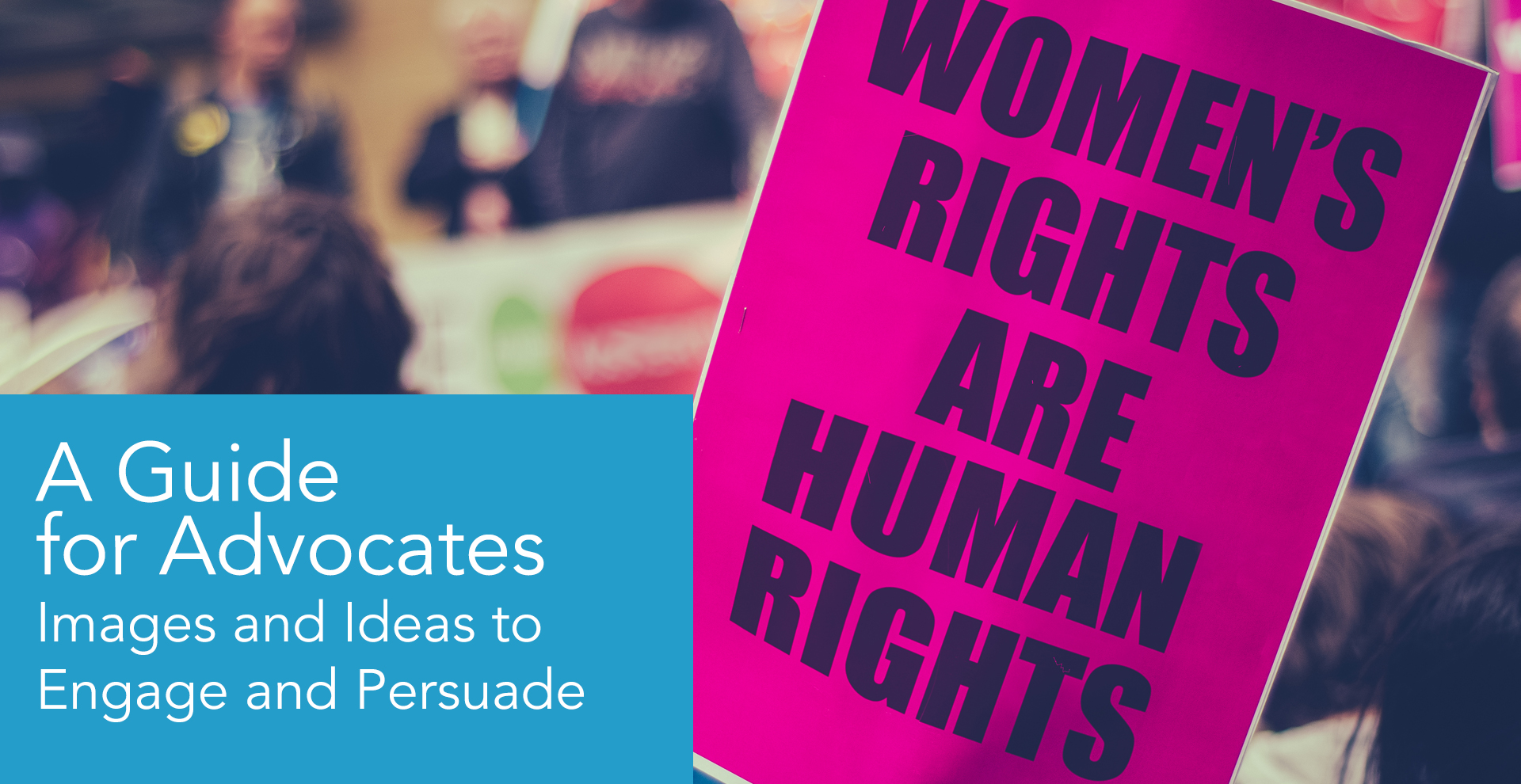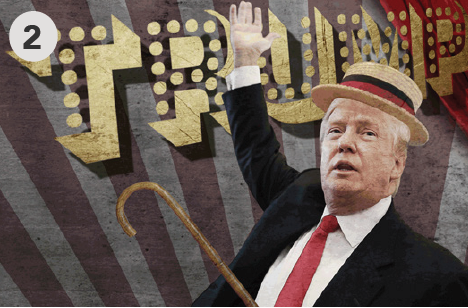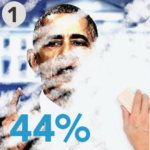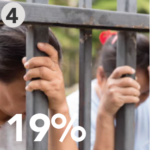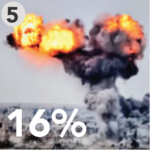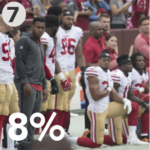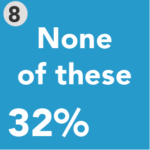Every month, we pick a few topics for exploration. The topics we select aren’t meant to cover every issue area facing the progressive community, but rather to give actionable advice on how to talk about the issues that are already central to the national discussion. This month we focused on:
Topic #1: Engagement vs. Exhaustion: What motivates people to take action, and what just makes them despair? On politics, Democrats feel more anger and Republicans feel more excitement. But Democrats are more exhausted than Republicans by a 2-to-1 margin. The progressive base can be engaged by focusing on big, substantive issue fights and by giving people opportunities to stay involved through movements and organized demonstrations.
Topic #2: What is the imagery defining Trump and the GOP, and how does it relate to Americans’ perceptions of Trump, the party, and the Republican agenda? Americans see narcissism and egotism as defining Trump’s personality, and self-interest as his primary motivation. Meanwhile, people view Congressional Republicans’ actions and agenda leading to corruption and higher costs for them.
1 | Turning Enthusiasm into Action, Not Exhaustion
There is no question that progressives are tuning into politics more now that Trump is in the White House. However, there is a delicate balance between motivating progressives and exhausting them before November. Progressives need to harness their anger into action.
In recent years, younger people have been defined by their lack of political engagement and we see similar challenges with Millennials today. But we also see opportunity. Millennials are much less likely to follow politics closely (67%) and say they will definitely vote this fall (54%) than those 35 and older (74% say they follow politics closely and 77% say they will definitely vote). But some groups within Millennials are newly engaged, with Millennial Democrats and younger Millennials saying they are following politics more closely today than ever before. Tapping into this audience is key to progressive fortunes.
Democrats, especially Millennial Democrats, are far more likely than Republicans to say their interest in politics is increasing.
Core progressive constituencies, including younger Millennials and African-Americans, are also paying closer attention to politics in the Trump era.
Following national politics and elections
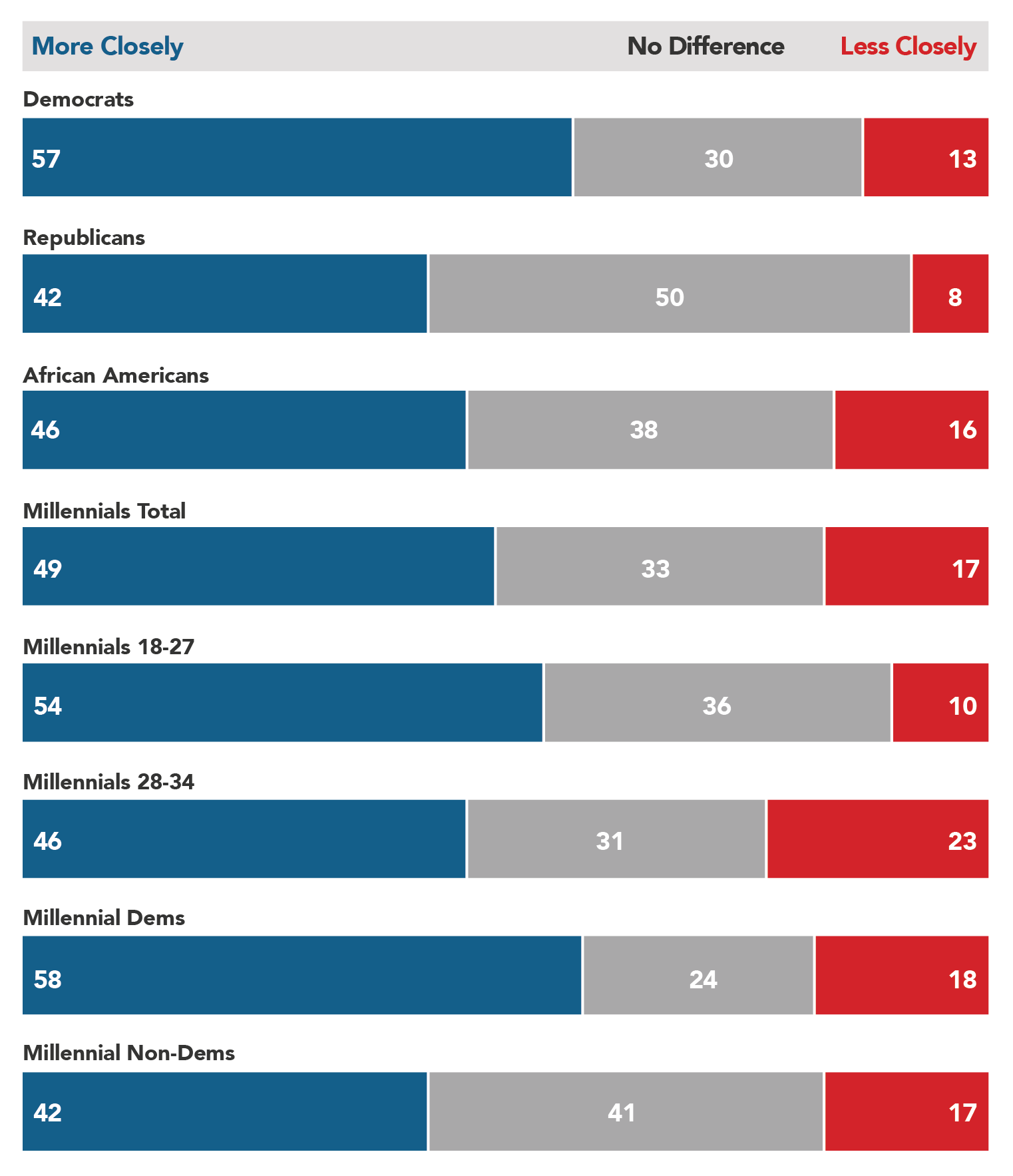
Democrats are angry and
exhausted.
Democrats clearly have strong, negative feelings about Trump. Over nine in ten (92%) disapprove of Trump’s job performance, including 79% who strongly disapprove.
Democrats are more likely to say they are “angry” about politics since Trump was elected (72% say so) than Republicans are to say they are “excited” (43% say so). But Democrats are also far more likely than Republicans to say they have felt “exhausted” by today’s politics.

The difference between anger and exhaustion.
“Angry” Democrats, in their own words, tend to focus more on what’s happening to the American people, with deeper social divisions and more suffering as a result of Trump’s policies. “Exhausted” Democrats tend to focus more on Trump and his administration, and are overwhelmed by the never-ending dysfunction and chaos.

Democrats on why they feel angry:
“Discrimination against whole groups of people”
“His lack of concern for those he considers beneath him, and suggesting policies to actively make their lives harder”
“The divisions that have been created in our country”

Democrats on why they feel exhausted:
“Every day more chaos”
“I am tired of the lies and scandals”
“He’s like a one man circus and it’s exhausting to watch”
1 | Using Issue Fights to Increase Engagement
Hot-button issue fights are stronger motivators than topics that feel settled or too late to change. Specific activism related to key issues is also more likely to motivate progressives than more generic protests.
Progressives feel most motivated by issues where there is lively, on-going national debate and a desired policy outcome (think guns or immigration). Additionally, we are better off being specific and direct in our appeals. As much as Trump inspires the passion of the Democratic base, when it comes to motivating people to act, people are more inclined to get involved in specific issue fights than to protest Trump in general.
Specific issue activism is key to keeping progressives engaged.
Public demonstrations — such as marches, strikes, and protests — around specific issues are more effective in engaging Democrats (and exhausting Republicans) than generic protests against Congress or Trump.
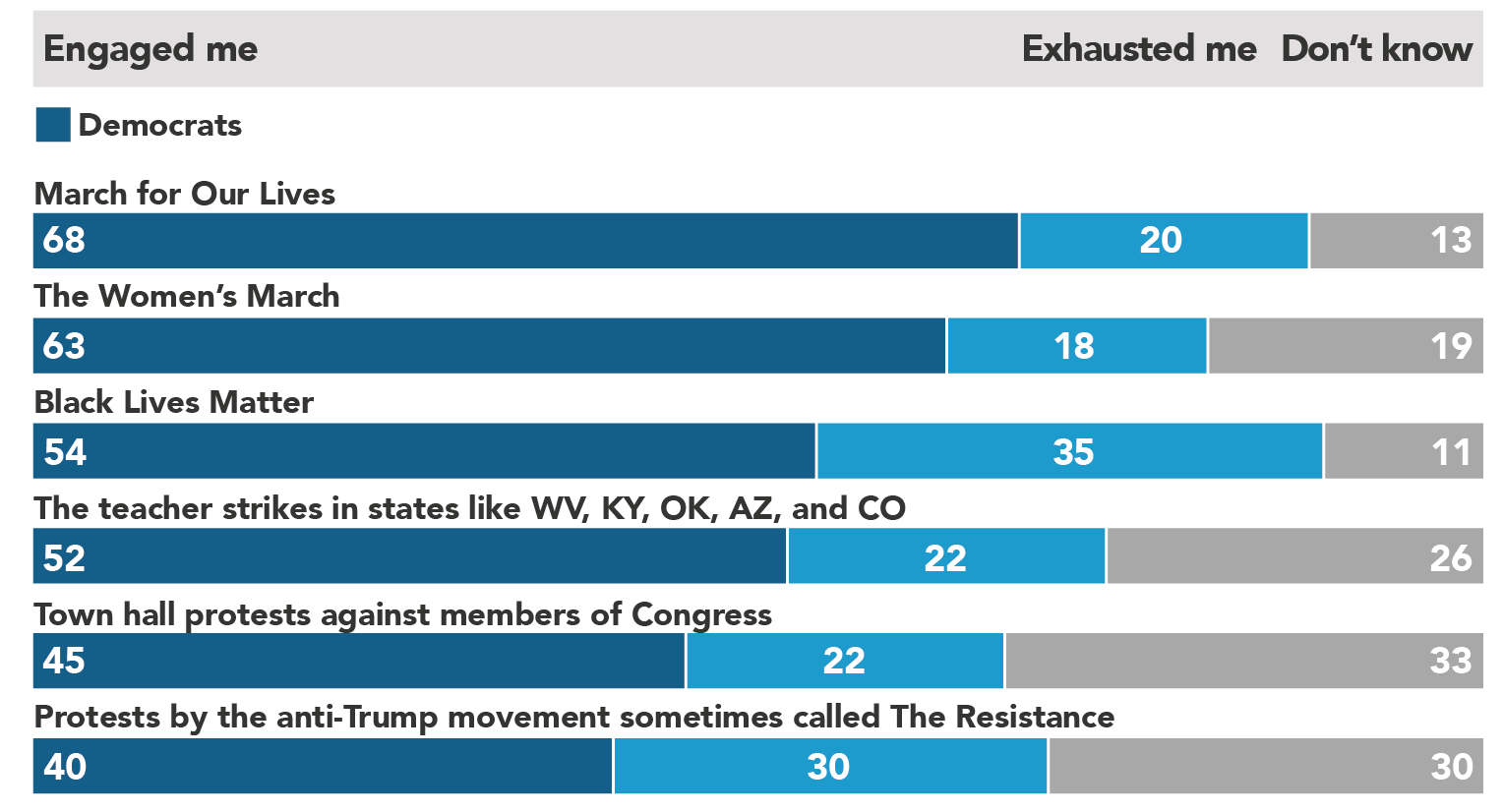
Leverage issues that are visibly in play, and avoid language that makes them feel final or backward-looking.
Big policy battles also have the potential to engage progressives even when there’s no direct, organized action. Ongoing debates on gun violence, immigration, and health care are all keeping Democrats engaged with politics. Progressives are less motivated by issue fights framed as already settled actions by the GOP. We should think about how to turn important issues like climate and taxes into forward-looking action.
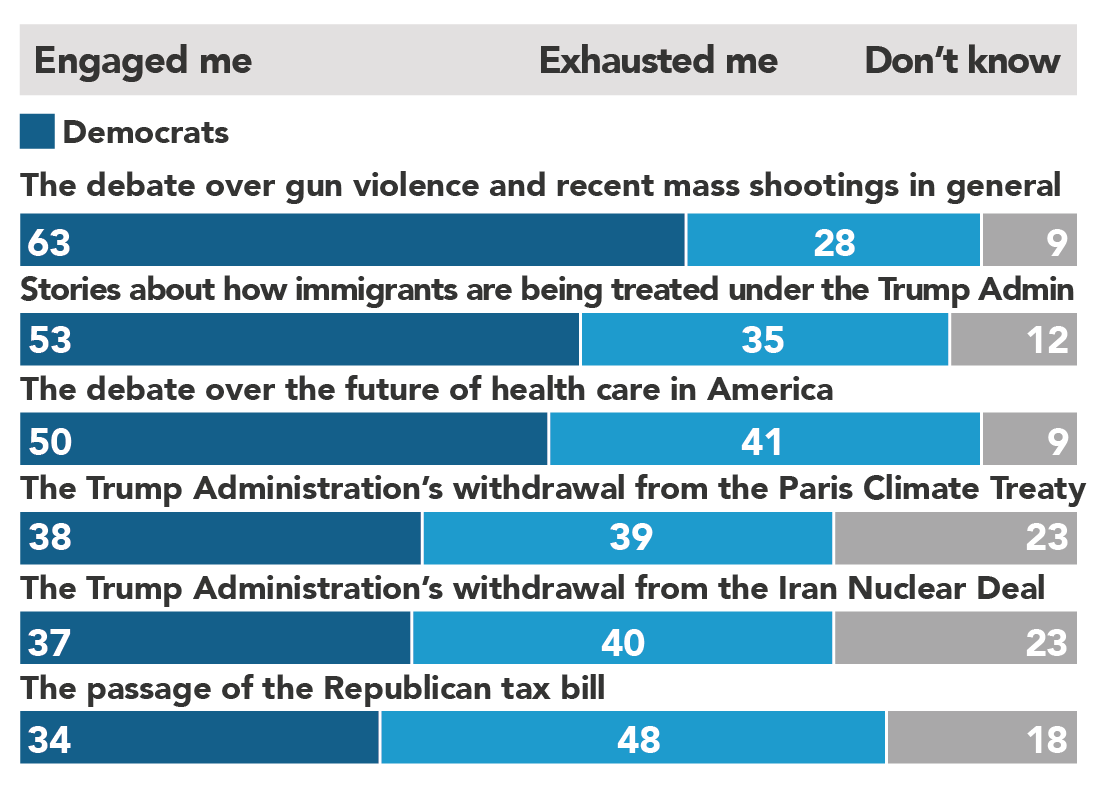
While Trump’s agenda makes Americans want to act, his personality exhausts them.
Topics relating to Trump as a person — including his use of Twitter and his dysfunctional administration — are the top sources of exhaustion for Democrats. Trump also risks exhausting Republicans by embracing chaos.
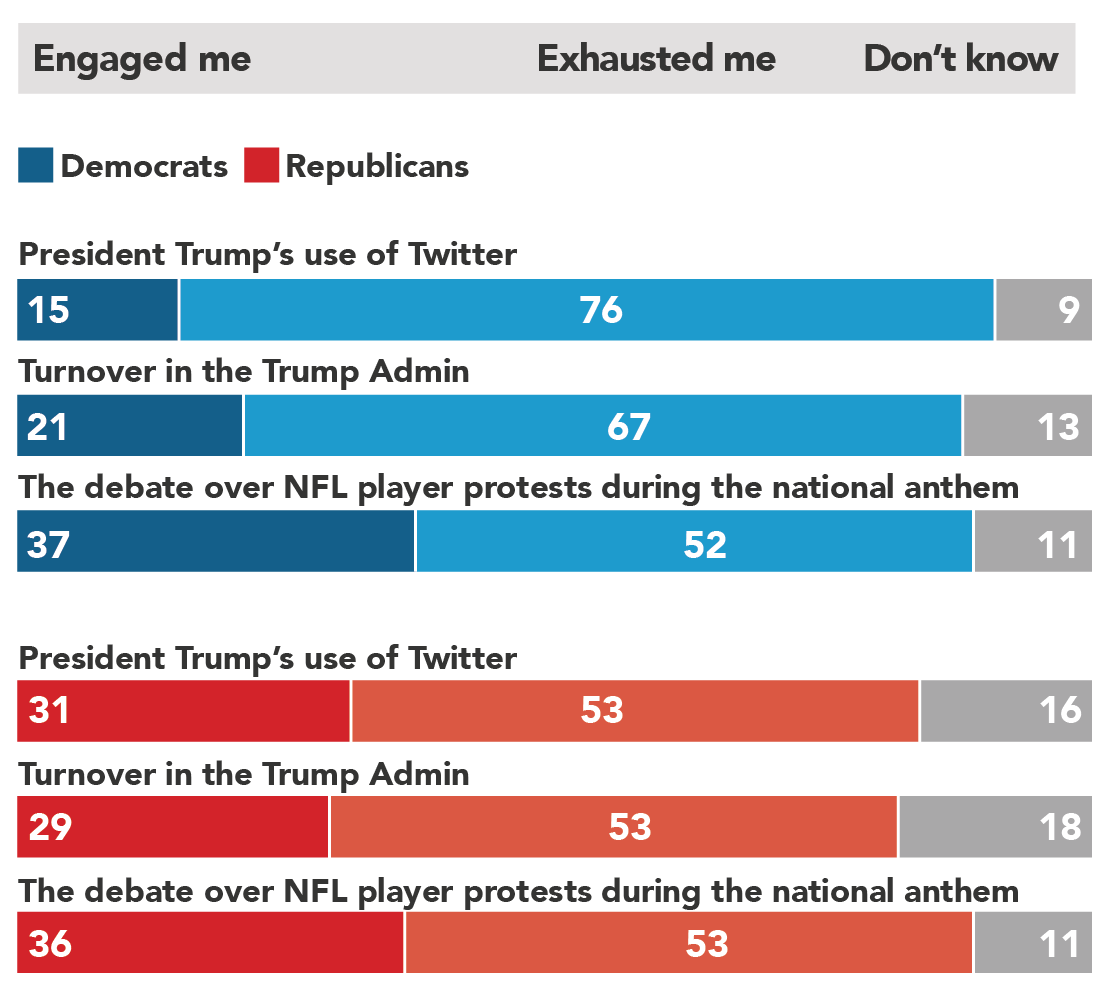
1 | Engaging Key Groups
Grassroots movements are engaging important audiences including African-Americans and Millennials. Democrats should focus on building on the energy of Black Lives Matter for African-Americans, and the March for Our Lives and Women’s March for Millennials.
However, it is important to keep in mind neither of these target groups are monolithic in their motivations. Health care, for example, is hugely important to younger African-Americans. And Millennials’ motivations diverge sharply when we segment them by party.
Black Lives Matter is a defining and activating issue for African-Americans.
A large majority of African-Americans (71%) say they personally identify with the Black Lives Matter movement, and it is also a strong source of engagement for African-Americans across age groups.
Among younger African-Americans 18-44, the debate over the future of health care in America is also a very strong engagement vehicle.
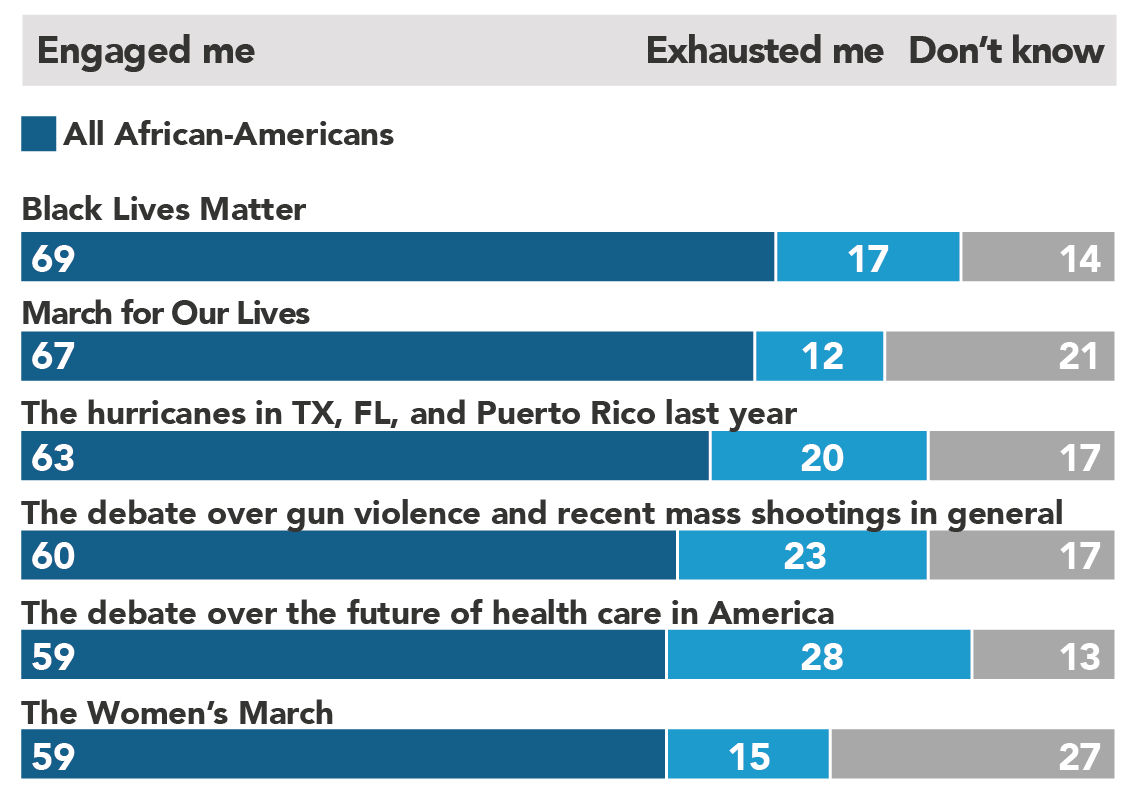
Millennial Democrats are most engaged by the March for Our Lives and Women’s March, but progressives should keep in mind that Millennials are still an ideologically diverse group.
While they are often talked about as a single block, Millennials are not immune from the partisan divides that we see across America. On these issues of activism, there are massive divides between Millennials who identify as Democrats and those who don’t.
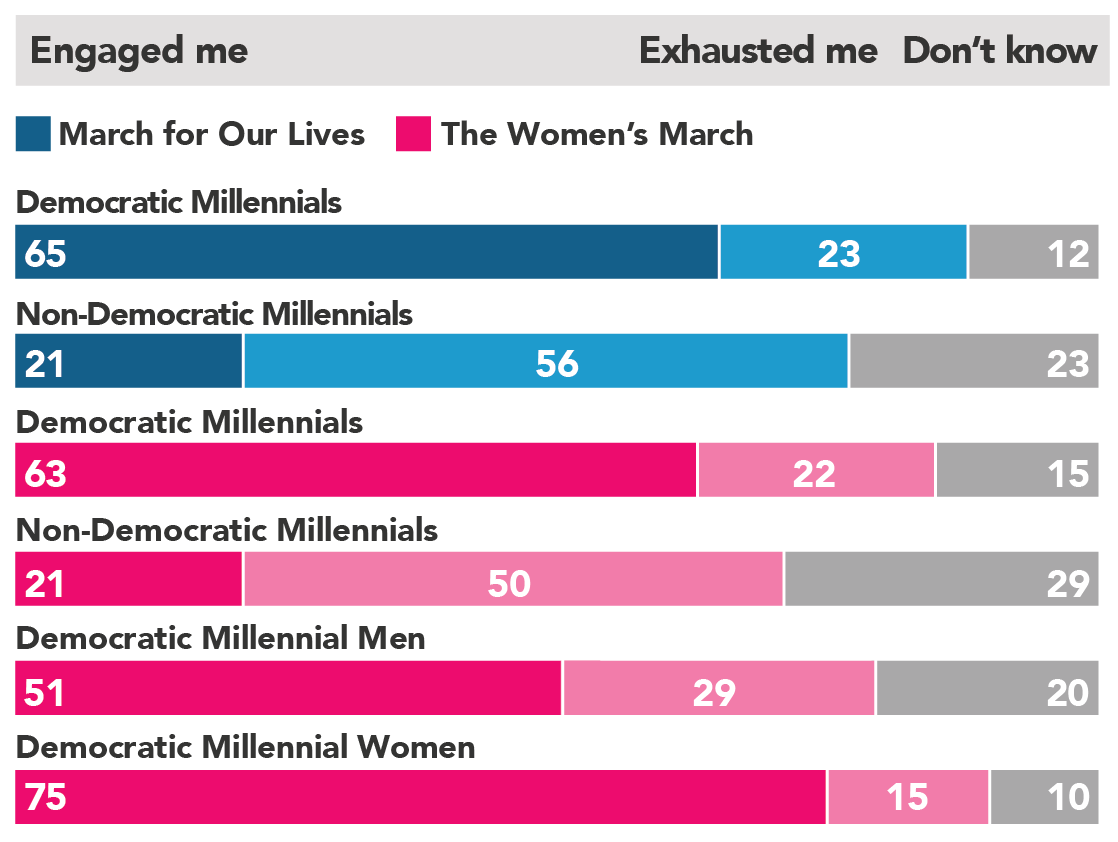
The special counsel investigation is unique in terms of activation. For Republicans, it is the single most “exhausting” item we tested. Among “disengaged Democrats” — those who aren’t following politics that closely or following less than in the past — it is also one of the most exhausting. For “engaged Democrats”, however — those paying attention most closely — it is one of the five most engaging topics.
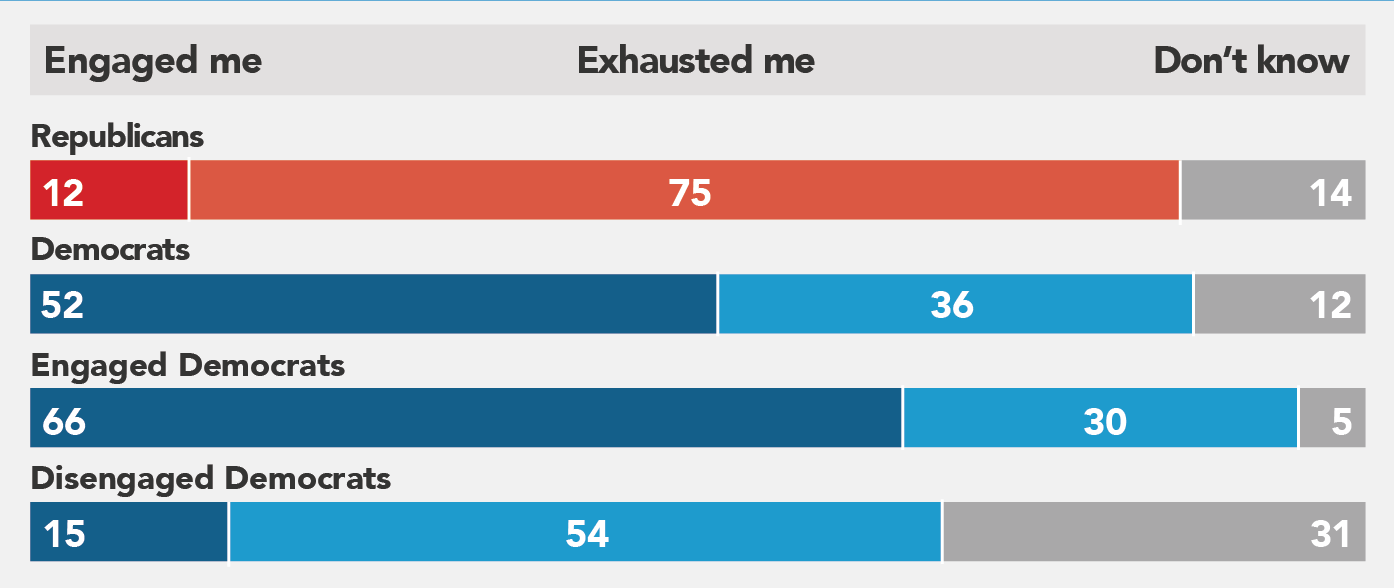
2 | Images: What Matters Most to Trump? Trump.
In our modern news environment, images often mean more than words. That’s why, for this month’s Navigator, we didn’t just poll language, but took a unique and innovative approach — testing the images that people identify with the current political moment in the public’s eyes. In fact, many of the images tested here came directly from respondents in our online discussion board, who were asked to search for images best reflecting their views on Trump and the political environment.
While Trump is often described around his temperament — as a mean bully or a crying toddler — respondents are twice as likely to choose a picture of Trump looking at himself in the mirror as the best representation of his personality. This has evolved from the last election where temperament was the greatest concern to a more deep character concern around his egotism.
A majority of Americans believe that Trump wants what is best for himself, rather than what is best for the country. And when asked to choose the words that concern them most about Trump, respondents choose “egotistical” and “narcissistic” over a host of others.
Progressives should also leverage these attitudes about Trump’s self-centeredness to cast doubt on whether he’s looking out for everyday working people. Most Americans believe Trump looks down on people like them, rather than respecting them.
Trump is all about Trump.
Trump’s narcissism, more than his tantrums and outbursts, defines his personality in the public’s eyes.
Trump’s personality. Which image better represents what you think Trump looks like on the inside?

Americans believe Trump’s self-centeredness is reflected in both the way he governs and the way he views the public.
Strong majorities view him as putting himself above what’s best for the country and that Trump looks down on “people like you.”
Which do you agree with more:
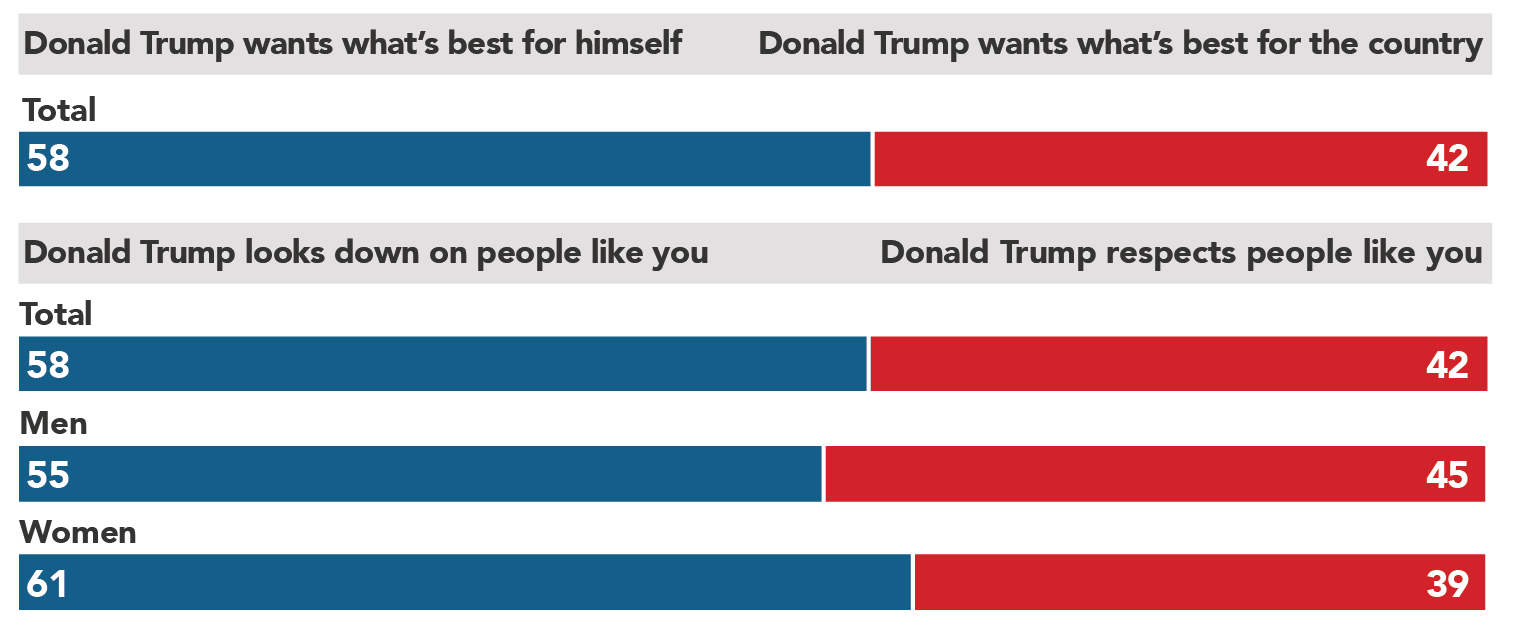
2 | Imagery: Trump now and later
When the dust settles on Trump’s chaotic tenure, Americans believe his lasting mark will be a more divided nation. The legacy people foresee for Trump isn’t the disorder he brought to D.C., but the disharmony he exacerbated for the country.
In Trump’s White House, chaos reigns supreme.
Respondents across partisan lines are more than twice as likely to choose a picture of a disorganized boardroom than a “White House for sale” as the defining image for Trump’s White House.
Trump’s White House. Which image better represents what you think it’s like inside the White House?

Americans don’t expect a happy ending to the show Trump is putting on.
Looking ahead, people believe the carnival atmosphere will give way to the real, sobering consequence of the country becoming even more divided.
Trump’s Legacy. Which image better represents how you think historians will look back on the Trump presidency?

What Trump really stands “for”? Erasing Obama’s legacy
For all the talk that Democrats need to be for something rather than just against Trump, respondents across partisan lines choose a picture of Obama being erased as the image that best represents Trump’s major policy goals. This echoes our findings that Americans see Trump as ultimately ego-driven, and it serves as a rebuttal of the notion that Democrats are the party that lacks a positive message. Democrats would no doubt be helped by communicating a clearer positive vision, but shouldn’t be afraid to put forth a similar and clearly credible critique of today’s GOP.
Percentages reported reflect top two choices of images.
Trump’s Administration policies. Which image better represents the major policy goals of the Trump Administration?
2 | Imagery: GOP Lawmaking — Corruption at a Cost
Whether we use imagery or words, there is a straight-forward and credible story connecting Congressional Republicans’ corrupt motivations to the harm their policies inflict on everyday Americans. People need to hear — and see — that everyday Americans are going to end up paying the price for Republicans’ corruption. We saw in April respondents believed Republicans passed the tax plan to help their donors, not the economy. That finding is echoed this month in the image respondents choose to explain their concerns with the GOP tax bill: money being passed under the table.
When it comes to Republicans’ other big legislative push to repeal the Affordable Care Act, Americans are most concerned about the costs to them. Progressive messaging on these two issues should paint a clear, cohesive narrative: Republicans are in someone else’s pocket — and now they’re coming after yours.
Concerns over rising costs drive opposition to the GOP’s health care plan.
Respondents who opposed Republicans’ repeal-and-replace plan say their biggest concern is that it raises costs (50% name this as a top concern), followed by notions that it is harmful (47%), irresponsible (43%), and cruel (37%).
The public still feels a shady deal was struck on taxes.
When opponents of the tax bill are asked to choose an image that illustrates their concerns, the perceived quid pro quo between politicians and donors bothers them far more than the image of the jet-setting rich who benefit most from it.
Which image represents what you didn’t like about the Republican tax bill?

Harm to seniors sticks with the Democratic base, but Americans in the middle point to costs as their biggest concern with the GOP health care plan.
Democrats are most likely to pick an image of “granny over the cliff” as best embodying their concerns with the GOP health care bill, while Independents gravitate toward money flying out of a wallet and pills spilling out to form a dollar sign.
Which image represents what you think about the Republican health care bill? And what is your second choice?

Percentages reported reflect top two choices of images.
Can Trump really pardon himself? Not if the public has a say.
- Nearly two-thirds of Americans (65%) say Trump’s claim about the ability to pardon himself concerns them, including 45% who say it concerns them a lot. Just 35% say it does not concern them.
- Concern Trump would overstep his authority in this way is not just a partisan issue; while Democrats, unsurprisingly, have the greatest concerns (92% concerned, 78% concerned “a lot”), even two in five Republicans (40%) say that Trump’s claims concerns them.
A related finding: Trump’s abuses of power emerging as a top concern
- When Americans are asked to pinpoint their biggest concerns about Trump (excluding those who “strongly disapprove” of him), the notion that he’s “unethical” and abuses power” is Americans’ second biggest concern after his “ego” and “narcissism.”
- This builds upon a finding in our first edition of Navigator that Trump’s “abuse of power” is much more concerning than what he’s doing to “preserve the honor and dignity of the Presidency.”
Still in the spotlight: Michael Cohen
- Last month’s survey showed Michael Cohen was one of the most widely disliked figures in Trump’s orbit (7% favorable/ 50% unfavorable), with few defenders even among the Republican base (13% favorable/43% unfavorable among Republicans).
- These negative numbers were echoed in our qualitative research this month, with voters easily able to identify Cohen as Trump’s lawyer and generally describing him in negative terms — “shady,” “scummy,” and even saying he “dresses awful.”
A long-term challenge:
Getting younger Millennials engaged at the local level
- As noted earlier, a majority (54%) of younger Millennials ages 18-27 are following national politics more closely than usual, making them even more engaged than older Millennials ages 28-34 (46%).
- But there is a big gap among this young Millennial cohort when it comes to more local engagement — just 34% say they’re following local and state politics more closely than usual, presenting a unique challenge for those seeking non-federal offices.
About The Study
Global Strategy Group conducted a public opinion survey among a base sample of 1,013 registered voters, along with 201 additional interviews of millennial voters aged 18-34 and 215 additional interviews of African-American voters, between June 12-17, 2018. The survey was conducted online recruiting respondents from multiple opt-in online panel vendors. Respondents were verified against a voter file and special care was taken to ensure that the demographic composition of our sample matched that of national registered voter population across a variety of demographic variables. The quotes and qualitative findings referenced in this document are from an online discussion board conducted by GBA Strategies June 4-6, 2018, of 34 voters who are not strong partisans.
